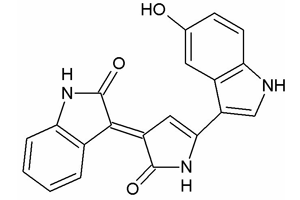Tough microbe communes produce compounds that kill predators
When marine bacteria join together in sticky biofilms, they produce lethal chemicals to protect themselves from predators, according to new research. Carsten Matz and colleagues at the Helmholtz Centre for Infection Research, Germany, say such chemical defence may be widespread in bacterial biofilms, and that understanding it could help combat a range of infectious diseases.
Matz’s team found compounds capable of dispatching grazing amoebae were released by 17 strains of bacteria when they formed biofilms (clusters of microorganisms encased in a tough polysaccharide matrix). When ingested by single-celled predators, the chemicals triggered a programme of automated cell death. ’The bacteria are clearly not just building a fortress, they are also fighting back,’ he says.
One of the compounds is the alkaloid violacein, a violet pigment known to be produced by several very different species of bacteria. When the researchers created a mutant bacterium that couldn’t make violacein, they found it was unable to defend itself. Biofilms formed by the mutant bugs were swiftly consumed by surface feeders. By contrast, predators grazing on ordinary violacein-producing bacteria were dead within 24 hours.

Lone free-floating bacteria don’t tend to invest in making defensive chemicals - perhaps because they are less likely to be detected by predators than a large biofilm. ’And metabolically, defence might be quite costly for a single cell, but a group can share the cost,’ says Matz.
Matz thinks similar chemical defensive strategies may be employed by many other biofilms. ’This seems to be a general phenomenon. I would say it’s not restricted to the marine bugs we studied,’ he says.
Biofilm-related infections pose a major risk to hospital patients, and the researchers hope that interrupting the production of defence molecules could help immune cells to break up biofilms. They are already investigating such ideas using Pseudomonas aeruginosa, a bacterium often found in biofilms on catheters. One route may be to target quorum sensing - cell-to-cell communication - in biofilm bacteria.
’This would be a very worthwhile line of investigation that could result in urgently needed anti-biofilm strategies,’ says Michael Wilson, a microbiologist studying biofilms at University College London. ’Of course, a number of other factors are involved [in biofilm survival], but it is impossible to ascertain at this stage the relative importance of all of these and if targeting them is going to produce any useful treatments.’
Another idea could be to use the defence molecules themselves to develop treatments for protozoan diseases, such as malaria. Matz’s team are currently screening a number of defence molecules for activity against protozoan parasites.
Hayley Birch
Enjoy this story? Spread the word using the ’tools’ menu on the left.
References
C Matz et alPLoS ONE3, e2744 (DOI: 10.1371/journal.pone.0002744)






No comments yet